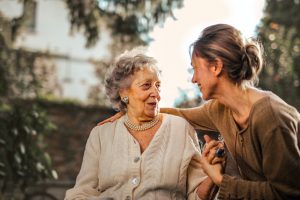Guest Blog: Common Skin Conditions Affecting the Elderly
No matter how well we take care of ourselves, advancing age eventually takes its toll – especially on our skin. Over time, the various components that make up our bodies gradually become less able to resist the onset of decay. The epidermis, which is the body’s largest organ, is no exception. As we age, it dries out, grows thinner, and becomes more vulnerable to disease. These naturally-occurring difficulties are compounded when an elderly patient is confined to a long-term care facility.
In some cases, a skin problem may indicate an underlying condition that has gone undetected. Skin conditions can also arise from problems in positioning for patients who are confined to a bed or a wheelchair for an extended period. Once the wound has been healed, the caregiver should make sure that its cause is determined and addressed, and nothing else is being overlooked.
While there are many possible skin disorders that can affect the epidermis of an elderly patient, not all of them will require treatment. Some do, however, and the following are a few of the more common conditions and their possible treatments.
Allergic Reactions
It has been estimated that approximately 5-10% of people 65 or older suffer from an allergic disease. In addition to those who suffer from allergies throughout their lives, some individuals only develop allergies once they reach an advanced age. Underlying medical conditions, memory issues, the use of several medications simultaneously, and overall poor health, can also contribute to the late appearance of an allergy problem in an elderly patient.
Prescription medications are often the culprit when a geriatric patient develops a systemic allergic reaction. Because of this, anyone who does have allergies should be asked about any recent new medications he or she may have begun taking. However, there are other potential causes, including exposure to detergents or mites. Allergic reactions can present in a wide array of symptoms, making it difficult to sometimes narrow down a specific cause.
Allergic reactions should always be treated with topical steroids for one to two weeks. The caregiver should also make sure that the cause of the reaction has been addressed.
Fungal Infections
The most common fungal infection, regardless of a patient’s age, is candidiasis, which is a yeast infection that tends to appear on occluded regions of the epidermis, such as in the folds of the skin or under dressings. It’s most dangerous to older patients and most transmittable to patients who are confined to bed or a wheelchair. In geriatric patients, candidiasis presents with chills, fever, pustular skin lesions, and in some cases, symptoms indicating sepsis.
Fortunately, candidiasis can be prevented by applying miconazole powder to at-risk patches of skin. When it does appear, it should be treated by applying clotrimazole or nystatin cream to the affected areas. If it becomes a recurring problem for patients, bowel eradication using nystatin pastilles should be considered. The provider should also be sure to check the patient for signs of retinal lesions, as many elderly patients suffer from cataracts.
Another common fungal problem is seborrheic dermatitis, which is caused by infection from a different type of yeast, malassezia furfur. It presents as red and scaly patches of skin typically found in areas where hair is present; particularly the head, neck, and chest. It can be treated with ketoconazole (nizoral) 2% shampoo or selenium sulfide 2.5% (Selsun Blue).
Staph and Strep infections
Staph and strep infections are also among the most common problems health professionals will face in patients at a long-term care facility. Studies have estimated that, at any given time, 30-40% of long-term care residents are experiencing a fungal infection.
A staph infection typically results when bacteria enter the epidermis through a sore or a cut (including in areas where a patient may be attached to a catheter or other medical device). The infection presents painfully as a red, swollen patch on the skin. This may be accompanied by pus drainage, a skin abscess, warmth in the area, and a fever as well. In more severe cases, patients may even experience shortness of breath, chills, chest pain, fatigue, muscle aches, headaches, and rashes.
When a geriatric patient is suffering from a staph or strep infection, it should first be treated with a topical antibiotic such as mupirocin (bactroban). If this does not cure the infection and it enters the surrounding tissue, a tissue culture should then be taken to determine what organism is causing the problem. Depending on the results, a systemic antibiotic – usually augmentin, bactrim, ciprofloxacin, or tetracycline – should be given to the patient.

